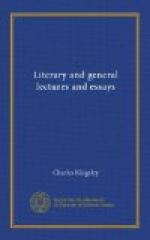These falsehoods have worked out their own punishment. The young are examining for themselves, and finding that we have deceived them, a revulsion in their feelings has taken place, similar to that which took place in Germany some half-century ago. They are reading the histories of the Middle Ages, and if we call them barbarous—they will grant it, and then quote instances of individual heroism and piety, which they defy us or any honest man not to admire. They are reading the old legends, and when we call them superstitious—they grant it, and then produce passages in which the highest doctrines of Christianity are embodied in the most pathetic and noble stories. They are looking for themselves at the ante-Raphaellic artists, and when we tell them that Fra Angelico’s pictures are weak, affected, ill-drawn, ill-coloured—they grant it, and then ask us if we can deny the sweetness, the purity, the rapt devotion, the saintly virtue, which shines forth from his faces. They ask us how beautiful and holy words or figures can be inspired by an evil spirit. They ask us why they are to deny the excellence of tales and pictures which make men more pure and humble, more earnest and noble. They tell us truly that all beauty is God’s stamp, and that all beauty ought to be consecrated to his service. And then they ask us: “If Protestantism denies that she can consecrate the beautiful, how can you wonder if we love the Romanism which can? You say that Popery created these glorious schools of art; how can you wonder if, like Overbeck, “we take the faith for the sake of the art which it inspired?”




